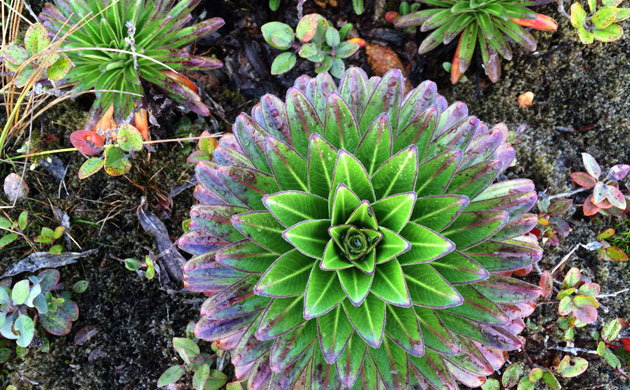Science and Conservation in Action
NTBG’s staff of highly trained scientists, researchers, biologists, and botanists work in the field, labs and nurseries to preserve and protect plants.

The world’s plants and their habitats are disappearing at an alarming rate, many even before they have been named or studied. Through our research efforts, NTBG is participating in the global effort to establish a scientific basis for ecological conservation and develop methods for sustainable plant utilization that benefit people while protecting the environment.
The focus of our research is identifying, documenting, understanding, and conserving the rich diversity of plants and their habitats in the tropics, with particular emphasis on the plants of Hawai’i and the greater Pacific region. The results of NTBG research in systematics (classifying and naming biological organisms and studying their relationships to each other) and floristics (the study of the plants or flora of a defined geographic or political region) contribute important knowledge of the world’s inventory of plant species. In conjunction with systematics and floristics, staff research focuses on plant propagation, economic plants and ethnobotany, paleoecology, invasive species, phytogeography, pollination ecology, seed conservation biology, and restoration ecology.
NTBG’s staff of highly trained scientists, researchers, biologists, and botanists work in the field, labs and nurseries to preserve and protect plants.
Plant systematics is a science that includes and encompasses traditional taxonomy (classification and naming), with the additional goal of understanding the evolutionary relationships among plants.
A main focus of systematic research at NTBG is the primarily tropical Rubiaceae, or coffee family, the world’s fourth largest flowering plant family, with 13,500 species belonging to more than 600 genera. Various species produce alkaloids responsible for their economic and medicinal utility. An important research and conservation collection of Rubiaceae has been established at the NTBG. These living collections are important resources not only for systematic studies, but also are being investigated for activity of plant extracts on biological processes that adversely impact human health in collaboration with investigators from the International Center for Tropical Botany (ICTB) and Florida International University (FIU).
Pteridophytes are important components of tropical plant communities and are another focus of systematic and floristic research at NTBG. This takes place through describing new species, writing floristic treatments, and via inter-institutional collaborations by sharing herbarium specimens and DNA samples collected by NTBG during the course of field work.
Phytogeography, the study of plant distributions, is built into all of the field work that NTBG conducts. Field researchers routinely map the distribution and abundance of rare Pacific island plants. Our herbarium (PTBG) houses all of this data through vouchered collections.
Understanding plant breeding systems is a fundamental component of plant conservation, and the need for information is even more pressing for rare plants that have co-evolved with specialist pollinators that may also be rare or even extinct. For instance, if a plant species is incapable of full or partial autogamy (selfing), a total loss of reproductive output may be experienced with loss of a pollinator, so human assisted pollination may be one management practice to implement as a first step.
Our research focuses on understanding the pollination ecology of Hawaiian species to inform best management practices for the species outlined in the Hawaiʻi Strategy for Plant Conservation.
In alignment with the Global Strategy For Plant Conservation, the Hawaii Strategy for Plant Conservation, and the National Seed Strategy we are investigating methods to preserve and protect Hawaiian species of conservation importance ex situ in the Seed Bank and Laboratory.
Our emphasis is determining seed and pollen storage behavior, seed longevity and aging kinetics, seed borne pathogen abatement, and seed dormancy and dormancy alleviation of native Hawaiian plant species of conservation importance. Our research aims to understand how seeds respond to desiccation and subfreezing temperatures, identifying regeneration intervals, and determining optimal seed propagation techniques.
Social-Ecological System Resilience is the study of human-in-nature systems with the particular goal of understanding how these systems recover from unexpected, catastrophic change over time.
NTBG’s Limahuli Garden and Preserve is located within the most biodiverse eco-region in the Hawaiian archipelago and leads the coordination of research efforts in the social-ecological system (ahupua’a) of Haena. Key social-ecological system research components include history, ethnography, archaeology, forestry, agroforestry, botany, limnology, hydrology, sea bird and fisheries biology.
The culmination of floristic and systematic research of the plants of a particular region is the publication of its Flora. A Flora, when using the term to refer to a publication, is a book, online resource, or other work that describes the plant species occurring in a given area (either geographic or political) or time period. The purpose of a published Flora is to allow identification of the plants described in it and provide an historical record of these plants.
Led by Senior Research Scientist Dr. David Lorence and collaborators, NTBG has been conducting and floristic research across the Pacific for several decades culminating in the publication of several major regional Floras. A New Flora of Fiji, a substantial work of over 3,000 pages has been published, and a Chronicle and Flora of Niihau, which combines a flora with an historical account of this small island.
In 2020 a 2 volume book Flora of the Marquesas Islands was published and NTBG published the Flora of Samoa in 2022. Continued fieldwork is conducted towards completing a Flora of Micronesia in the coming years. Several of the published and planned book Floras are preceded by online Floras. See more details about some of NTBG’s Flora projects.